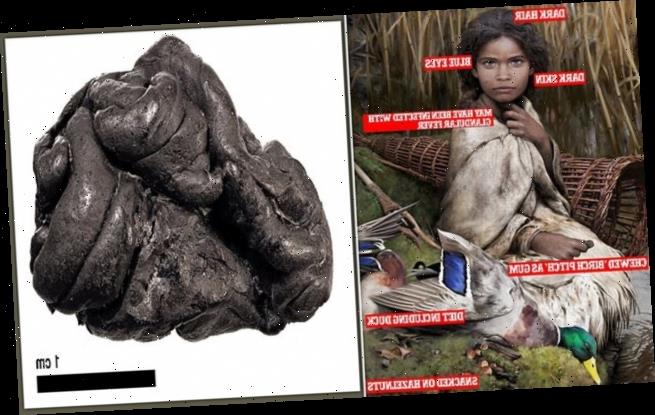DNA analysis of ancient birch ‘chewing gum’ reveals it was chomped by a Danish hunter-gatherer with dark skin and blue eyes who dined on duck and hazelnuts 5,700 years ago
- Lump of birch pitch gum was unearthed on the Danish island of Lolland
- Analysis of the DNA trapped inside revealed details of the piece of gum’s history
- Found plentiful human genes as well as duck, hazelnut and viral DNA
- Researchers pieced together the information to piece together an image of what the person chewing it was like
DNA analysis of a lump of ancient ‘chewing gum’ made from birch pitch has revealed the life of a person who lived 5,700 years ago in unprecedented detail.
The preserved gum was unearthed on the Danish island of Lolland and provided scientists with enough information to recreate the individual’s entire genome.
Primitive gum, made from heated up birch bark, has previously been found at archaeological sites and experts believe it was used as a glue and as chewing gum by children.
Scientists believe that the person who once chewed the gum was a hunter-gatherer woman with dark skin, dark hair and blue eyes, who lived on a diet of duck and hazelnuts.
She would have looked different to the native Scandinavians of the time, researchers say, and was more closely related to ancient people from mainland Europe.
As well as human, duck and hazelnut DNA, bacterial and viral pathogenic DNA was also preserved in the inch-long chunk of birch pitch.
Further analysis revealed the prehistoric hunter-gatherer may have been infected with the Epstein-Barr Virus, which can causes infectious mononucleosis or glandular fever.
Scroll down for video
Genes from the gum reveal the person was probably a woman and likely had dark skin, dark hair and blue eyes (pictured) who had a diet of duck and hazelnuts. Closely-related to hunter-gatherers from mainland Europe, she would have looked different to the native Scandinavians of the time
WHAT IS BIRCH PITCH?
Birch pitch has been used as a glue since the Middle Pleistocene era – approximately 760,000 to 126,000 years ago and and is created by heating birch bark.
Small lumps of this material have been found at archaeological sites and have often included tooth imprints, suggesting it was chewed.
Analysis of what is preserved inside can shed light on who was chewing it.
Researchers say it has potential in unravelling our ancestral microbiome.
It can also help understand the spread of pathogens and how they have evolved and spread.
This study is the first time scientists have obtained the full genome of an ancient human without using their bones.
Associate Professor Hannes Schroeder from the Globe Institute, University of Copenhagen, who led the research, said: ‘It is amazing to have gotten a complete ancient human genome from anything other than bone.
‘What is more, we also retrieved DNA from oral microbes and several important human pathogens, which makes this a very valuable source of ancient DNA, especially for time periods where we have no human remains.’
Based on the human genome, the researchers could tell the ancient gum was chewed by a female.
She was genetically more closely related to hunter-gatherers from mainland Europe than to those who lived in central Scandinavia at the time.
Her complexion was also determined from analysis of her genome, published in the journal Nature Communications.
Researchers found traces of hazelnut and duck DNA in the sample, which indicate they may have made up part of her diet
The chewed birch pitch was found during archaeological excavations at Syltholm, east of Rodbyhavn in southern Denmark.
In addition, the researchers extracted DNA from several oral microbiota from the pitch, including many commensal species and opportunistic pathogens.
They also found DNA that could be assigned to the Epstein-Barr Virus, which is known to cause infectious mononucleosis or glandular fever.
According to Professor Schroeder, such ancient chewing gums bear great potential in researching the composition of our ancestral microbiome and the evolution of important human pathogens.
He said: ‘It can help us understand how pathogens have evolved and spread over time, and what makes them particularly virulent in a given environment.
‘At the same time, it may help predict how a pathogen will behave in the future, and how it might be contained or eradicated.’
Source: Read Full Article

